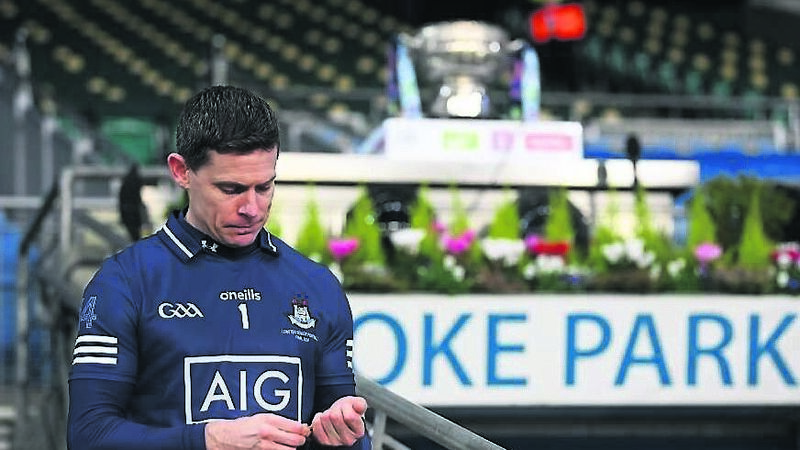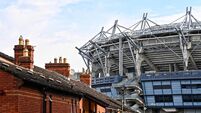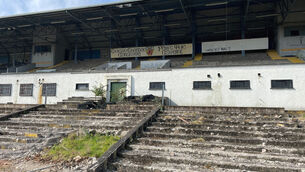Paul Rouse: Be it Croke Park or Camp Nou, home advantage counts

Dublin captain Stephen Cluxton after lifiting the Delaney Cup following the Leinster final win over Meath last month. Picture: Stephen McCarthy/Sportsfile
The manner in which Dublin dismantled Meath was so absolute that a tipping-point has been reached.
Meath are the second-best team in Leinster. They have made good progress under Andy McEntee to the point where there was a general sense that they had closed the gap on Dublin.
It was not that people could be found who were really convinced that Meath would beat Dublin in the Leinster final, rather the belief was that they would be competitive – at least for stretches of the game.
Instead, the opposite happened. The game was over by the first water-break. Dublin were so utterly dominant in every phase that it was as if the teams were playing two different sports.
If the final was the immediate context of the dismay about the state of Leinster football, the fact that it was Dublin’s 10th Leinster championship in a row is a true reflection of their dominance.
It is impossible to think of even one game across those ten years when it seemed likely that Dublin would be beaten. It is hard even to think of a game where it was conceivable.
Even Leinster finals have been a succession of non-events.
As things now stand, it is difficult to see any Leinster team defeating Dublin in a championship match in the foreseeable future. It is in this context that Ciarán Whelan said that the rest of Leinster were “psychologically smashed” and that Colm O’Rourke spoke of “humiliation”.
When you even get to ask a question such as “Would Dublin beat a selection of the Rest of Leinster?” you know you are in an entirely unbalanced competition.
This unbalance is the product of a generation of players who are outstanding. They are the best squad ever to play Gaelic football. Their skill levels are immense and they play with a relentlessness that is unmatched.
They have been – and are – brilliantly managed and the whole support network around the Dublin senior football team is exemplary.
The bottom line is that there is no sense now that Dublin are going to disimprove any time soon. Indeed, they have transitioned out players such as Paul Flynn, Diarmuid Connolly and the Brogans and their superiority is undiminished.
Competitiveness in Leinster will only come through raising the quality of the footballers – and the teams – being produced in the other counties.
In this, the counties must look to themselves in the first instance. Why are they not producing better footballers? Is the coaching good enough? Is the recruitment good enough? Are the clubs and the schools doing their work properly? Are internal structures and calendar of play maximised in each county?
But there are also two other issues that merit consideration. The first relates to whether the funding given to counties is equitably distributed. And the second relates to where intercounty matches are being played.
These are questions which apply to the Association as a whole, not just to Leinster.
The first issue was set out by the Westmeath footballer John Connellan in his recent letter – the issues he raised demand a proper answer at the highest levels of the GAA.
As for the second issue – home advantage – this was raised again in the aftermath of the Leinster final, with calls for Dublin’s All-Ireland semi-final against Cavan to be played at a neutral venue.
And of course Croke Park is de jure a neutral venue, while also being de facto the place where Dublin footballers play all their home league and championship matches.
What advantage does playing so many home matches confer on Dublin?
Academics from a range of different disciplines (economists, statisticians, mathematicians, psychologists and so on) have looked at home advantage in sport for some 50 years.
Although there is no consensus in these studies about precisely why home advantage matters, it is nonetheless broadly accepted that its “existence is well-established”; that is to say, in sports competitions, home teams ordinarily win more than 50% of matches.
For example, a 2005 article in the Journal of Sports Sciences examined long-term trends in home advantage in elite sport in America and England. Two academics – the Pollards – examined more than 400,000 games from:
- The American and National Baseball Leagues (1876–2002);
- The National Hockey League (1917–2003);
- The National Football League (1933–2002);
- The National Basketball Association (1946–2003);
- All four levels of the Football League in England (1888–2003).
There were variations in all the leagues across time and some sports had higher levels of home advantage than others but home advantage was demonstrably real.
In baseball, this is put at some 54% across almost all of the decades that have passed since the first professional baseball leagues were established in 1876. In the other sports, home advantage fluctuated from 55% to more than 70% in certain years – but it relatively consistently stood at around 60%.
In other competitions – for example in the Italian and Spanish soccer leagues which a study addressed in the mid-1980s – home advantage was put at 76.1% and 76.3%, respectively.
The question is repeatedly asked as to what factors were the causes for home advantage to matter.
The judgment of the Pollards here seems sensible: “There appear to be many causes for home advantage, each contributing a small amount and interacting with each other in ways that vary from sport to sport.”
For example, crowd effects, travel, familiarity with the surface, referee bias, and psychological factors have all been set out as factors. There is, of course, an overlap between some of those so disentangling them is a particularly thorny challenge.
Crowd effects and referee bias are obviously intertwined: a crowd is claimed to matter because of its effect in raising the performance of the home team relative to the away team and also to influence the officials to “subconsciously favour the home team”.
It is clearly the case that home advantage is essentially irrelevant when the gap between two teams is significant; where it may matter, however, is when there is a tight game. Across all sports, the evidence produces fascinating nuggets of information.
For instance, a play-by-play study of more than 16,000 NBA basketball games showed that the scoring rates of teams playing at home were consistently higher.
What is also of interest is that, if a pitch surface in a stadium is markedly different than that of other surfaces it, too, increases the impact of home advantage. The size of a pitch, the cut and nature of the grass, the speed of the ground – all of these things are practical aspects of play that are understood through familiarity.
Ultimately, the evidence across all major field sports is that home advantage matters.
And it appears that the Gael does not stand immune from this global phenomenon. A 2014 piece by Prof John Considine (UCC) on the brilliant sportseconomics.org website shows that win percentages for away teams in the three provincial football championships (Connacht is an outlier due to the presence of London and New York) in the 2008-11 period is between 33% and 44%.
That fits nicely within the global story of home advantage. We can dress this up any way we want, we can explain it and justify it, but the bottom line is that home advantage matters.








